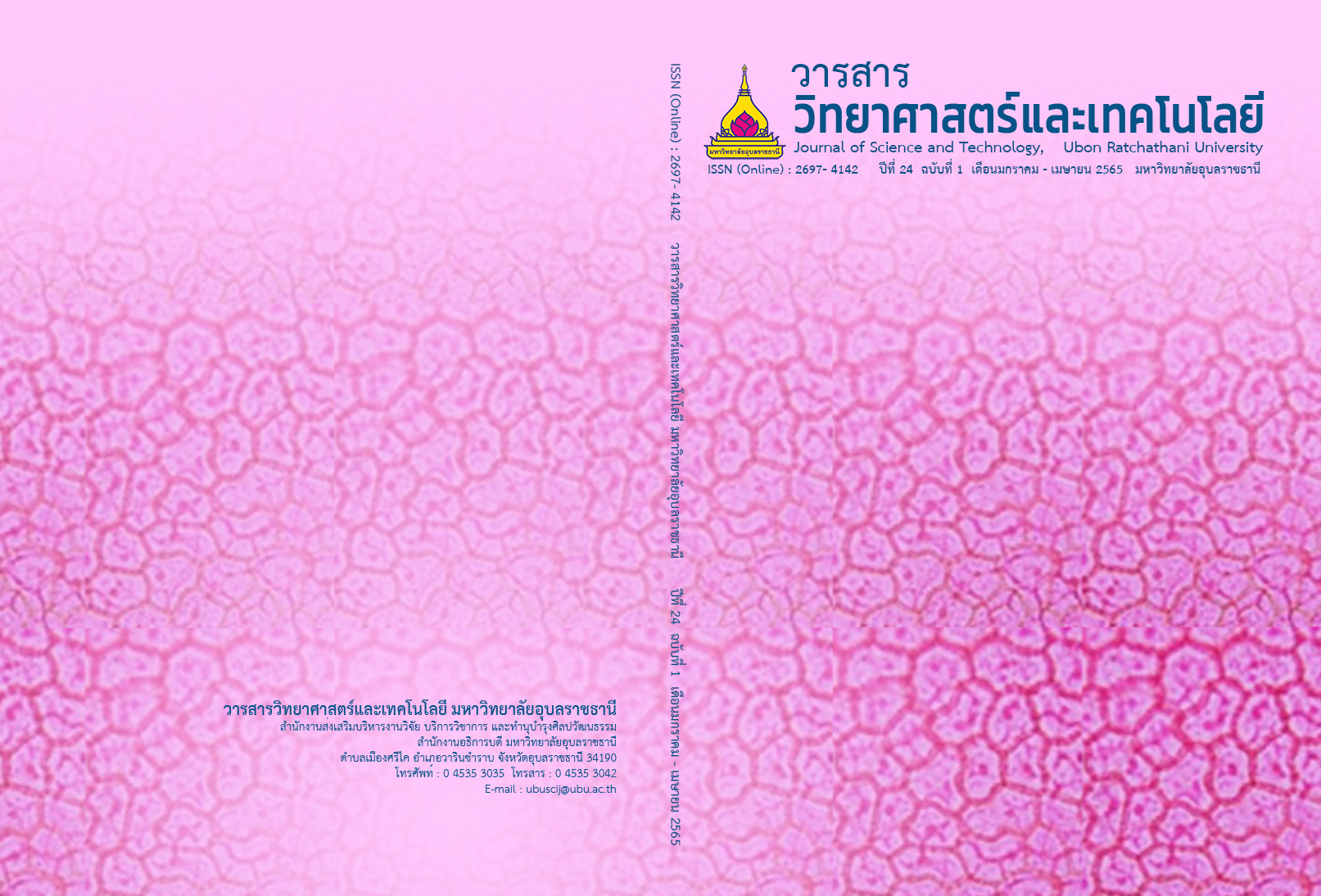การพัฒนาเครื่องดื่มเวย์โปรตีนเพื่อสุขภาพ
Main Article Content
บทคัดย่อ
งานวิจัยได้นำเวย์โปรตีนที่มีความบริสุทธิ์ร้อยละ 95 มาพัฒนาสูตรต้นแบบเครื่องดื่ม พัฒนากระบวนการผลิต วิเคราะห์คุณค่าทางโภชนาการ และประเมินคุณภาพทางประสาทสัมผัส พบว่าการให้ความร้อนที่อุณหภูมิ 60 องศาเซลเซียส เป็นสภาวะที่เหมาะสมที่สุดในการผลิตเครื่องดื่มเวย์โปรตีน ได้สารละลายที่มีลักษณะใส ไม่มีตะกอน มีความเงา วาว เมื่อตั้งทิ้งไว้อย่างน้อย 8 ชั่วโมง ยังคงไม่เปลี่ยนสภาพ เมื่อปรับปรุงสูตรเครื่องดื่มด้วยการเติม β-cyclodextrin ในอัตราความเข้มข้นที่แตกต่างกันเพื่อลดความขมฝาดเฝื่อนของเครื่องดื่มเวย์โปรตีน สูตรเครื่องดื่มที่ผสม β-cyclodextrin ที่ความเข้มข้นเท่ากับ 0.05% มีผลต่อการลดความขมฝาดเฝื่อนโดยตรง ผลการประเมินคุณภาพทางประสาทสัมผัสโดยผู้ทดสอบชิมจำนวน 50 คน ด้วยวิธี scoring test สอดคล้องกับผลที่ได้จากการทดสอบรสชาติเครื่องดื่มเวย์โปรตีนด้วยเครื่อง taste sensing system โดยพบว่าเครื่องดื่มที่ผสม β-cyclodextrin ที่ความเข้มข้นเท่ากับ 0.05% มีรสชาติความขม ความฝาดเฝื่อน และความรู้สึกภายในปากหลังการกลืนน้อยลงอย่างมากเมื่อเปรียบเทียบกับเครื่องดื่มที่ไม่ได้ผสม β-cyclodextrin นอกจากนี้ได้พัฒนาสูตรเครื่องดื่มเวย์โปรตีนปราศจากน้ำตาล โดยใช้สารให้ความหวาน sucralose และ aspartame แทนน้ำตาล การประเมินคุณภาพทางประสาทสัมผัสด้านความชอบและการยอมรับของผู้บริโภคจำนวน 115 คน พบว่าเครื่องดื่มเวย์โปรตีนสูตรที่เติมน้ำตาลทรายมีค่าความชอบเฉลี่ยสูงสุด 6.17 ไม่แตกต่างจากเครื่องดื่มเวย์โปรตีนสูตรที่เติมสารให้ความหวาน aspartame ที่มีค่าความชอบเฉลี่ย 5.82 อย่างมีนัยสำคัญทางสถิติ ดังนั้นเครื่องดื่มเวย์โปรตีนสูตรที่เติมสารให้ความหวาน aspartame จึงสามารถเป็นทางเลือกให้ผู้บริโภคที่รักสุขภาพที่ไม่ต้องการบริโภคน้ำตาล จากการวิเคราะห์คุณค่าทางโภชนาการของเครื่องดื่มเวย์โปรตีน พบว่ามีปริมาณโปรตีนสูงถึง 8.67 กรัม/100 มิลลิลิตร ปราศจากไขมัน และมีพลังงานทั้งหมด 36.5 กิโลแคลอรี/100 มิลลิลิตร ซึ่งเหมาะสำหรับเป็นเครื่องดื่มเพื่อสุขภาพ
Article Details

อนุญาตภายใต้เงื่อนไข Creative Commons Attribution-NonCommercial-NoDerivatives 4.0 International License.
บทความที่ได้รับการตีพิมพ์เป็นลิขสิทธิ์ของ วารสารวิทยาศาสตร์และเทคโนโลยี มหาวิทยาลัยอุบลราชธานี
ข้อความที่ปรากฏในบทความแต่ละเรื่องในวารสารวิชาการเล่มนี้เป็นความคิดเห็นส่วนตัวของผู้เขียนแต่ละท่านไม่เกี่ยวข้องกับมหาวิทยาลัยอุบลราชธานี และคณาจารย์ท่านอื่นๆในมหาวิทยาลัยฯ แต่อย่างใด ความรับผิดชอบองค์ประกอบทั้งหมดของบทความแต่ละเรื่องเป็นของผู้เขียนแต่ละท่าน หากมีความผิดพลาดใดๆ ผู้เขียนแต่ละท่านจะรับผิดชอบบทความของตนเองแต่ผู้เดียว
เอกสารอ้างอิง
Lee, Y.M. and et al. 2007. Effect of a milk drink supplemented with whey peptides on blood pressure in patients with mild hypertension. European Journal of Nutrition. 46(1): 21-27.
Indrani, D. and et al. 2007. Influence of whey protein concentrate on the rheological characteristics of dough, microstructure and quality of unleavened flat bread (parotta). Food Research International. 40(10): 1254-1260.
Solak, B.B. and Akin, N. 2012. Functionality of whey protein. International Journal of Health & Nutrition. 3(1): 1-7.
Kanthawut, B. 2002. Improvement of Drinking Yoghurt by Using Whey Protein Powder to Replace Skim Milk Powder. M.Sc. Thesis, Kasetsart University. (in Thai)
Helbig, N.B. and et al. 1980. Debittering of skim milk hydrolysates by adsorption for incorporation into acidic beverages. Journal of Food Science. 45: 331-335.
Shaw, P.E. and Buslig, B.S. 1986. Selective removal of bitter compounds from grapefruit juice and from aqueous solution with cyclodextrin polymers and with Amberlite XAD-4. Journal of Agricultural and Food Chemistry. 34: 837-840.
Normah, I. and Nurul Fasihah, R. 2017. Evaluation of -cyclodextrin masking effect on the Bitterness of angelwing clam (Pholas orientalis) hydrolysate. International Food Research Journal. 24(4): 1500-1506.
Badal, C. S. and Kiyoshi, H. 2001. Debittering of protein hydrolyzates. Biotechnology Advances. 19: 355-370.
Tamura, M. and et al. 1990. Practical debittering using model peptides and related compounds. Agricultural Biological Chemistry. 54: 41-51.
Akasha, A.A., Elwahedi, M.A. and Eldeeb A.M. 2014. Cyclodextrins and their pharmaceutical application. PharmaTutor. 2(7): 40-46.
Kale, V., Tapre, C. and Ittadwar, A. 2013. Gustatory system and masking the taste of bitter herbs. International Journal of Pharmaceutical Sciences and Research. 4(11): 4118-4124.
Liu, R.X. and et al. 2017. Traditional human taste panel and taste sensor methods for bitter taste masking research on combined bitterness suppressant of Berberine hydrochloride. Sensors and Materials. 29(1): 105-116.
Chay, S.K. and et al. 2018. Evaluation of the taste-masking effects of (2-hydroxypropyl)--cyclodextrin on ranitidine hydrochloride; a combined biosensor, spectroscopic and molecular modelling assessment. RSC Advances. 8: 3564-3575.
Latimer, G.W.Jr. 2016. Official Method of Analysis of AOAC International. 20th edition. Rockville: AOAC International.
Sullivan, D.M. and Carpenter, D.E. 1993. Methods of Analysis for Nutrition Labeling. Arlington: AOAC International.
Wiriyacharee, P. 2002. Sensory Evaluation. Chiangmai: Chiangmai University Press. (in Thai)
Wiriyacharee, P. 2012. Experimental Design. Chiangmai: Chiangmai University Press. (in Thai)
De Wit, J.N., Hontelez-Backx, E. and Adamse, M. 1988. Evaluation of functional properties of whey protein concentrates and whey protein isolates. III. Functional properties of aqueous solution. Netherlands Milk and Dairy Journal. 42: 155-72.
Fox, P.F. and McSweeney, P.L.H. 1998. Dairy Chemistry and Biochemistry. Glasgow: Blackie Academic and Professional.
Loftsson, T. and Brewster, M.E. 1996. Pharmaceutical applications of cyclodextrins: 1. Drug solubilisation and stabilization. Journal of Pharmaceutical Science. 85: 1017-1098.
Yoshikazu, K. and et al. 2010. Advanced taste sensors based on artificial lipids with global selectivity to basic taste qualities and high correlation to sensory scores. Sensor. 10: 3411-3443.
Yusuke, T. and Kiyoshi, T. 2013. Electronic tongues-A review. IEEE Sensors Journal. 13(8): 3001-3011.


